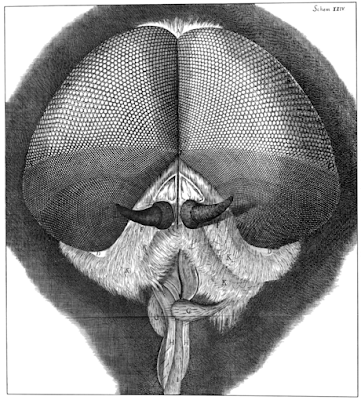 Drawing of a grey drone fly(꽃등에) published in Robert Hooke's Micrographia of 1665.
Drawing of a grey drone fly(꽃등에) published in Robert Hooke's Micrographia of 1665.
Compound eyes
A compound eye may consist of thousands of individual photoreception units. The image perceived is a combination of inputs from the numerous ommatidia (individual "eye units"), which are located on a convex surface, thus pointing in slightly different directions. Compared with simple eyes, compound eyes possess a very large view angle, and can detect fast movement and, in some cases, the polarization of light.[12] Because the individual lenses are so small, the effects of diffraction impose a limit on the possible resolution that can be obtained. This can only be countered by increasing lens size and number — to see with a resolution comparable to our simple eyes, humans would require compound eyes which would each reach the size of their head.
Compound eyes fall into two groups: apposition eyes, which form multiple inverted images, and superposition eyes, which form a single erect image.[13] Compound eyes are common in arthropods, and are also present in annelids and some bivalved molluscs.[14]
Compound eyes, in arthropods at least, grow at their margins by the addition of new ommatidia.[15]




댓글 없음:
댓글 쓰기